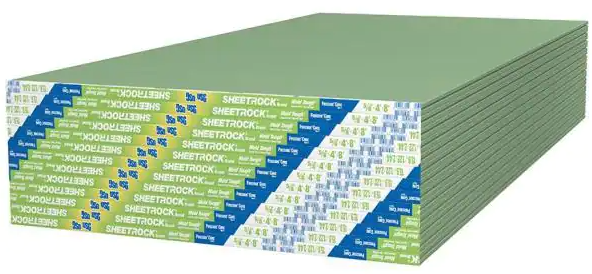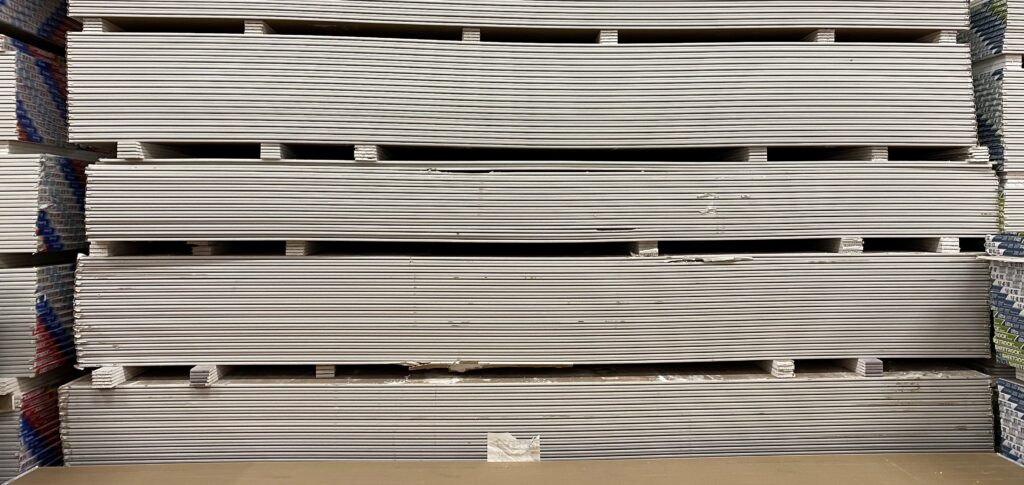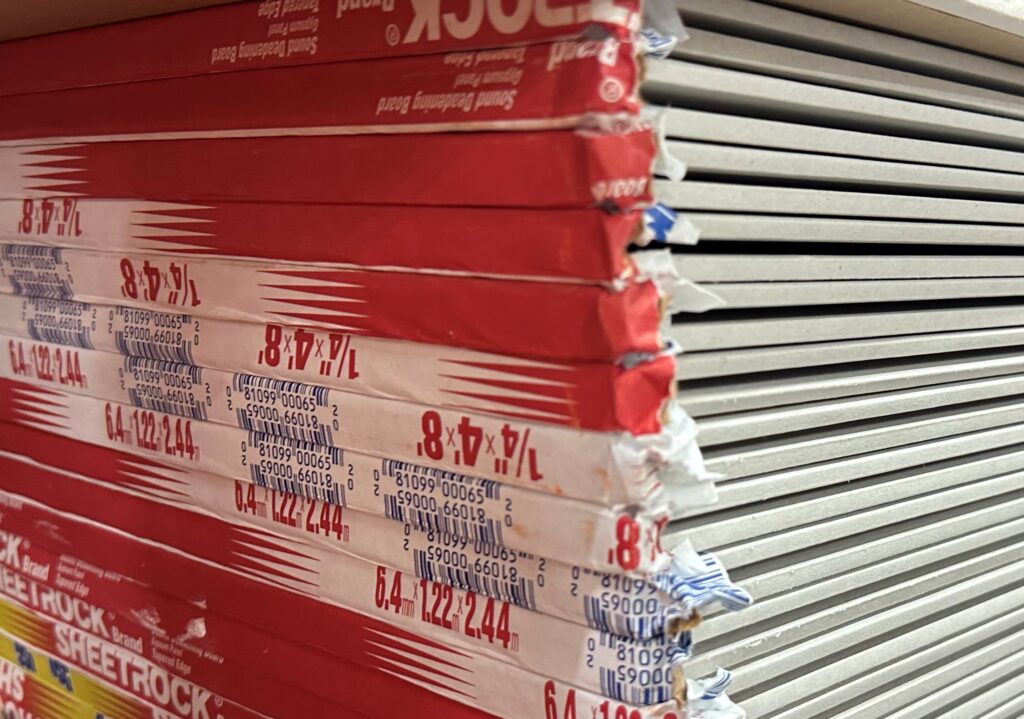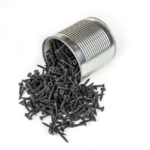If you’re planning to hang drywall in your basement, moisture and mold resistance should be at the top of your list when selecting the right type.
There are several other considerations beyond the type of drywall. Don’t forget about the thickness and how you will get the material into the basement.
Stud and joist spacing and local codes will also play a role in planning before you can have a successful project.
What Type of Drywall Should I Use In My Basement?
Fiberglass mat and paperless drywall is ideal for basements because it offers superior moisture protection.
It also helps stave off mold growth, keeping indoor air quality and living environment healthy. And fiberglass drywall is just as easy to install as regular drywall, so you can get the job done quickly.
Green Board
Green board is one of the best options for moisture-resistant drywall. It is designed to withstand moisture, mold, and mildew better than regular drywall.
This makes green board perfect for basements and other areas where you need extra protection against moisture. When properly installed, green board is a great choice to keep your home dry in wet conditions.

Purple Board
Purple board is an ideal insulation option for basements or other areas where moisture resistance is important.
This helps to prevent mold and mildew growth and ensures that your walls stay dry and free from any moisture damage.

Should I Use Drywall to Finish My Basement?
If you’re a beginner looking to finish your basement, drywall is the way to go. Gypsum is a lightweight material that’s easy to install and provides the perfect texture for painting or wallpapering.
It’s also quite affordable, making it an ideal choice if you want to get the job done on a budget. Additionally, gypsum is durable and resists wear and tear, so it’s great for homes with active kids or pets.
With gypsum drywall, you can transform your basement into the perfect finished space. So if you’re looking to finish your basement on a budget, gypsum drywall is the way to go.
If you’re wondering what other options there are to drywall in your basement, plywood paneling or shiplap could be a good option. Although total costs might be higher than simply drywall walls.

Stud Spacing for Drywall?
Regarding interior basement walls, the stud spacing is different from the exterior walls. Generally speaking, you can use wider stud spacing when installing drywall in an unfinished basement.
Rather than using 16″ on center, you could go with 24″ on center spacing for the basement walls.
It is important to note that this may vary depending on local building codes, so it is always best to check with your local code enforcement agency before beginning any project.
Should My Basement Drywall Be Moisture Resistant?
Whether you should use moisture-resistant drywall in your basement depends on your home’s climate and moisture levels.
Basements are prone to moisture buildup due to their location below ground, so moisture-resistant drywall (also known as green board or purple board) is often recommended for basements.
This type of drywall is specially designed with moisture protection in mind and can help prevent mold growth due to moisture buildup.
If you have a basement with high moisture levels or live in a humid climate, moisture-resistant drywall panels are likely your best bet for ensuring moisture protection.
After your drywall hanging and taping is complete, consider using Kilz Mold & Mildew Primer to protect from moisture issues down the road.
The Kilz Primer product features mold-reducing properties not found in regular primers.
What Size and Thickness Drywall Should I Use on Basement Walls?
The most common size drywall for basements is 4×8. This size offers the benefit of fitting easily through doorways and tight spaces.
It’s much easier to install than larger sizes like 4×10 or 4×12. Especially if you are working as a one-person crew!
4×8 drywall is also the most common size available at home improvement stores. However, if your space can accommodate larger sheets of drywall, such as 4×10 or 4×12, they can often be found stocked at your local home improvement store as well.

These larger pieces can cover more area faster and provide a smoother, cleaner look to your walls. Larger sheets will also be easier for the taper to finish because of fewer butt joints to tape.
When choosing the appropriate drywall thickness for your basement finishing and renovation project, 1/2″ and 5/8″ are typically the most common sizes.
1/2″ is ideal if you want a lightweight material that can easily be cut and installed, while 5/8″ provides added strength and stability.
The 1/2″ option is suitable for most basement ceilings, while 5/8″ type X sheetrock is typically reserved for walls requiring fire ratings.

What Size and Thickness Drywall Should I Use on Basement Ceilings and Soffits?
For basement ceilings and soffits, 1/2-inch drywall is typically a good choice. It’s lightweight enough to be easily installed. If hanging on existing ceiling joists, check the spacing before ordering your drywall.
You may need Type X 5/8 inch drywall in some cases if your local fire codes or building codes require greater protection from heat and flames.
Should My Drywall Touch the Floor in a Basement?
Your drywall should never touch the floor in a basement. Keep the drywall 1/2″ to 3/4″ off the concrete floor to prevent moisture from seeping up into the drywall and drywall paper.
Once moisture seeps into the drywall paper, mold and mildew could become an issue.
When hanging drywall in your basement, use plywood or 1×4 spacers to assure the drywall is off the floor when it’s screwed into the wall studs.
How To Install Drywall Basement Walls
Installing drywall in basement walls is a fairly straightforward, tedious process. To begin, you’ll need to measure the square footage for each wall and use that information to estimate the total square feet of drywall required.
Then it’s time to purchase your supplies: utility knife, tape measure, T-square, drywall hammer, drywall screw gun or drill, and screws for attaching the drywall. Of course, you’ll need drywall itself.
When the installation is complete, you can prime and paint the new drywall for an extra layer of protection from moisture – particularly important in a basement setting.
How to Drywall a Basement Ceiling
The process for drywalling a basement ceiling starts with measuring and cutting sheetrock to the dimensions of your ceiling joists, then attaching them securely to those joists.
Be sure to use screws that are appropriate for sheetrock and avoid overdriving them, as this can damage the sheetrock and weaken its attachment to the joists.
Once the sheetrock is attached to the ceiling joists with drywall nails or screws, it’s time to move on to the soffits.
You’ll need joint compound to cover the seams and screws between each drywall panel and any other cracks or holes that may have appeared.
After applying joint compound, allow it to dry before sanding any rough spots. Finally, you can apply primer and paint to your newly sheetrock basement ceiling.
Should the Drywall Sheet End on a Stud?
The butt ends of your drywall sheets should always end on the middle of the stud framing. Before beginning to attach the drywall sheet to the wall stud, assure each end of the sheetrock splits the stud right down the center.
If it doesn’t end on a stud, cut the drywall to length so that each joint splits half-way onto the wall stud on both sides of the sheet.
If you’re hanging drywall on a beam or column, be sure the drywall has solid backing on all sides.
Tips for Installing Drywall in Your Basement –
- Lay poly or a large tarp across the floor to save clean-up time. Drywall installation is a mess. This will make clean-up a bit easier.
- With painter’s tape, mark the location of each stud on the floor so you can easily screw it into the wall stud once the drywall is hanging.
- Set up a place to cut the drywall. Measuring and marking off the sheet for cutting will take a dedicated space.
Cutting Holes for Electrical Boxes in Drywall
- Measure the height and width of the wall or ceiling down to the electrical box outlets.
- Using a level or straight edge, mark the location of the electrical box outlet on the drywall sheet.
- Double-check the measurements to be sure you’re ready to cut.
- With a drywall keyhole saw, cut out the hole for the electrical box or outlet switch.
- If using a router to cut around electrical outlets after the drywall is hung, take extra care to avoid electric wiring behind the drywall.
Should I Install Drywall Over Concrete Walls?
Installing drywall over basement concrete walls is a great way to transform your basement remodel into an inviting, comfortable environment.
First, prep the area by cleaning off any dust or debris from the concrete walls. This will ensure that the drywall is mounted securely and that no objects on the wall could interfere with this process.
Next, use wood furring strips, or studs for solid backing for your sheetrock.
Is My Basement Waterproof?
When it comes to basement finishing and creating a comfortable atmosphere for your home, one of the most critical questions is: Is my basement waterproof?
Waterproofing your basement is essential to prevent moisture from seeping into your living space. This can cause mold growth and other issues that can be harmful to you and your family’s health.
Fortunately, there are many waterproofing solutions available that can help protect your basement from water damage.
Professional contractors should be able to recommend the best waterproofing solution for your basement environment and any existing conditions. Solutions could include:
- Installing a waterproofing membrane
- A sump pump
- Adding dehumidification systems
- Using specialized sealants to protect against water damage
Properly waterproofing your basement is an essential part of creating a safe, comfortable environment for your home.
Taking the necessary steps to waterproof your basement can help ensure that your living space remains dry and free from water damage.
With the right solution in place, you will have peace of mind knowing that your basement is well protected against moisture.
Is Basement Finishing a Good DIY Project?
Basement finishing can be a great DIY project for homeowners looking to maximize their living space. However, take precautions before embarking on this type of project.
One such precaution is egress – egress means that there must be an emergency exit in case of fire or other emergencies.
If your basement is not properly egress-compliant, it cannot legally be used as living space.
Once all these considerations are weighed, basement finishing can be a great DIY project for homeowners.
Hanging sheetrock in a basement can be a challenging task, but it is certainly one that you can do yourself.
Should I Soundproof My Basement?
When it comes to soundproofing the basement, acoustical wall panels are a great way to go. Wall panels absorb noise and vibrations by providing an additional layer of insulation between interior walls.
They come in different shapes, sizes, materials, and colors – so you can choose something that fits your basement’s environment.
Installing acoustic wall or ceiling panels is a great way to reduce sound transmission and create a quieter space.
Other methods for soundproofing your basement might be suitable depending on the type of noise you are trying to reduce. These include wall insulation, acoustic ceiling tiles, and carpets or rugs.
With acoustical wall panels and other soundproofing technologies, you can make sure that your basement is as quiet as possible.
UL Wall Assemblies – USG Handbook



